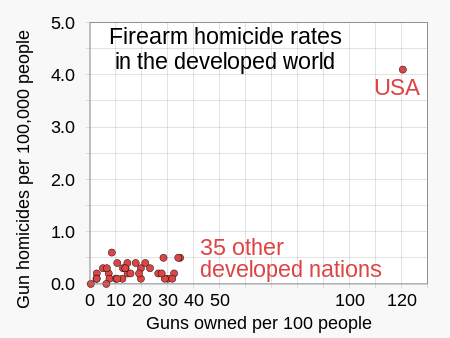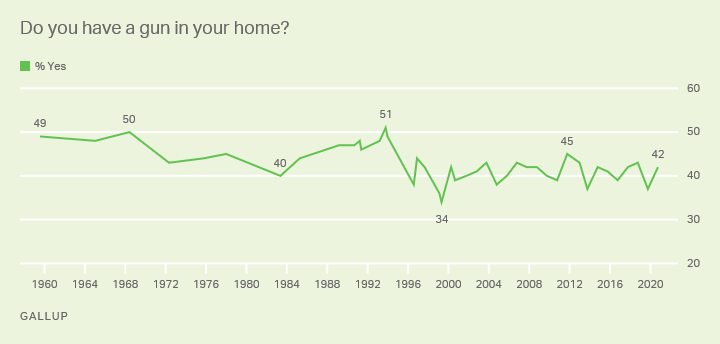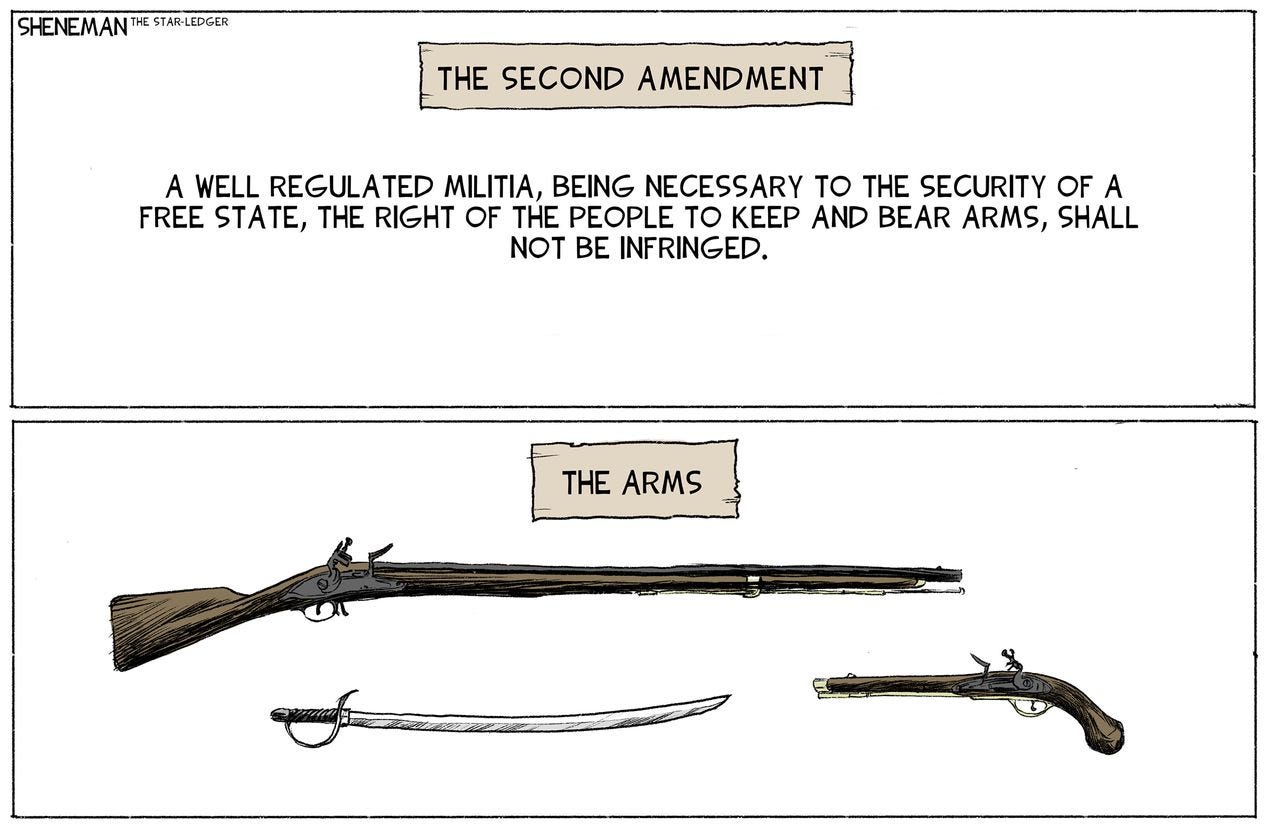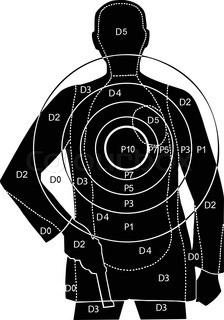Our Do-Nothing Congresswoman
On May 26, 2022, two days after a shooter wielding an assault rifle fatally shot nineteen students and two teachers at Robb Elementary School in Uvalde TX, one of my readers wrote to U.S. Rep. Cathy McMorris Rodgers (CD-5, Eastern WA). He implored her to support legislation that would at least ban high capacity magazines, or, better, ban civilian ownership of weapons of war. As usual, McMorris Rodgers ignored the plea and stuck flawlessly to Republican talking points supporting “sober conversations”, “mental health”, and claiming credit for helping pass (in 2018) two impressive sounding laws, the STOP School Violence Act and the Fix NICS Act, neither of which accomplishes anything substantive. STOP offers grants for “hardening” schools; Fix NICS penalizes certain government agencies for not reporting to the National Instant Criminal Background Check System (NICS). McMorris Rodgers claims she was “a vocal advocate for the Department of Justice review and subsequent banning of bump stocks” in the Fix NICS legislation—but she neglects to mention that banning bump stocks (apparently a huge concession for CMR) didn’t make it into the final law. (You might remember bump stocks as a topic of discussion after the 2017 Las Vegas shooting that killed 60 music festival participants and wounded 411 more. All a bump stock does is further increase the rate of fire of an already ridiculously effective people-killer. No mass murderer has bothered to use a bump stock since that shooting.) (The text of CMR’s letter is copied at the very bottom of this email—for those who can bear to read it.)
The bottom line on CMR’s stance on the assault weaponry that is killing us: “I want you to believe that I’m doing important things in Congress to address this issue, but I will never vote for any bill that limits in any way the civilian ownership of weapons of war.” It should be clear to all who read her letter that the only way to obtain federal action on this issue is to vote McMorris Rodgers and her fellow Republicans in the U.S. Congress out of office.
McMorris Rodgers just doesn’t “get” it. The “arms” borne today far surpass in people-killing capacity anything the Founders knew or contemplated. Modern assault weaponry also far surpasses firearms we still heavily regulate in this country (as I pointed out in Where is the National Will?, People Killers and the refusal to act).
Doug Muder, who writes the highly recommended Weekly Sift, nails this issue in his June 6, 2022 post, America’s guns have changed in my lifetime, The guns I grew up with wouldn’t have been much use in a massacre. Mr. Muder, like me, grew up in Midwestern gun culture. His main point: The same percentage of American households own guns now as they did in the 1960s—but the guns they own are very, very different. Click the link to his article or read the copy I’ve added below (and sign up for his posts, if you haven’t already).
Keep to the high ground,
Jerry
America’s guns have changed in my lifetime
Doug Muder
The guns I grew up with wouldn’t have been much use in a massacre.
Comparing the United States to other countries is one of the most powerful arguments for gun control. Recurring mass shootings is a problem unique to the US, and so it requires an equally unique explanation. Other industrialized countries also have mental illness, video games, abortion, secularism, and all the other factors NRA-sponsored politicians and pundits raise to divert attention from guns. But other wealthy countries don’t have America’s mass-shooting problem, or its gun-violence problem in general, because they don’t have America’s guns.
It really is that simple.

The best attempt I’ve seen to counter this argument is to compare the US not with any other country, but with our own past: The problem can’t be the sheer number of guns in the US, because Americans have always owned a lot of guns.
Gallup has been asking about gun ownership since the 1960s, and the percentage of American households with guns has been fairly stable, perhaps even showing a slight downward trend.

Mass shootings weren’t considered a major problem in 1960, this counter-argument goes, so the cause can’t just be guns. Whatever the X-factor is, it has to be something that has changed in recent decades. That, presumably, is how people come to blame video games, abortion, and secularism, despite their presence in other countries.
The flaw in this logic is that the guns of America’s civilian arsenal have changed a lot in recent decades. Yes, a lot of Americans have always owned guns. But they didn’t own guns like this.
You’ll often see this point made about the guns of the 18th century, the ones the Founders had in mind when they wrote the Second Amendment — as in this cartoon.

What’s not as well appreciated is how much guns have changed in living memory. My memory, for example.
Sometime in my pre-teen years in the late 1960s, my Dad thought it might be a bonding experience for us to go hunting. So he bought a 12-gauge shotgun for himself and a .410 shotgun for me. His held five shells and mine three. Both moved new shells into the firing chamber with a pump action. Pumping could throw off your aim, so without a lot of practice it was just about impossible to shoot even the five or three shells quickly, at least if you wanted to hit anything.
And while reloading wasn’t that hard, once you got onto it, it wasn’t nearly as quick or easy as snapping in a new clip. But it didn’t need to be. The point was to keep firing until your quarry either fell or fled, which would probably happen in a matter of seconds. After that, you were looking at another extended period of stalking — that’s why the sport is called “hunting” rather than “shooting” — so you had plenty of time to dig a few shells out of a pocket and slide them into the shotgun.
Dad also owned a .22 rifle, which typically lived out on our farm, about 15 miles from our house in town. I don’t remember how many bullets it held, but it wasn’t many. I occasionally shot targets with it, but not with any practical goal like hunting or self-defense. (A post on a survivalist message board is blunt about such a rifle’s self-defense limitations: “A .22 round has virtually no ‘stopping power’. It takes a hit directly to vital organs like the heart or brain to ‘stop’ somebody with a .22.”)
That was our whole arsenal. We were, I believe, a more-or-less typical gun-owning family of the era. (At least in the rural Midwest. Perhaps things were already different in the South; I wouldn’t know.) Many of my friends had a similar exposure to guns, which they used (rarely, and under adult supervision) to hunt quail or ducks or rabbits. (I once ate fried squirrels that a neighbor had killed. They did indeed taste like chicken.) I heard about men going on deer-hunting trips, but I don’t remember my friends bragging about hunting deer themselves.
One possible use for our guns never came up: killing people intentionally. Everyone knew, of course, that a shotgun or a rifle of any caliber could kill someone. Occasionally I would hear about hunting accidents, or that someone (though not anyone I knew personally) had committed suicide with a gun. My dentist once surprised burglars at his vacation home, and they shot him with a shotgun they were stealing from him. (At least that’s the story I remember hearing. He lived, but ever after had marks on his face from where the pellets hit. Years later he became the father-in-law of my best friend from elementary school.)

But shooting people was an accident to be avoided, not something we trained to do. For practice we shot at bottles or clay pigeons, not human figures on paper. Dad and I never talked about repelling a home invasion with our shotguns, and I doubt he had such a plan. (Our home would have been pretty easy to invade in the summer, when we often just fastened a screen door with a hook. The shotguns were in the basement and unloaded. Using them quickly would have been difficult. If Dad secretly kept a more convenient gun, I believe I would have found it when I cleaned out the house after he died.) And we certainly never discussed joining a group that might fight against the government.
The guns also were not a part of our identity, either as individuals or as a family. They were sporting equipment, like baseball gloves or basketballs, and had little symbolic significance. So we did not assemble a collection to display with pride, or join a shooting club, or hang around in gun shops. I don’t think I knew what the NRA was.
I had a toy M-16 as a kid, so I knew about such weapons, which soldiers were using in Vietnam. Apparently the civilian semi-automatic version, the AR-15, was already on the market. But it never occurred to me that we might buy one. (Why would we? If you hit a rabbit with a burst from an AR-15, there wouldn’t be much left.)
In short, our gun-owning household didn’t have anything like the destructive capability that millions and millions of American households have today. If I had ever gone on a rampage with our guns, I couldn’t have run up anything like the body counts we’ve seen lately, and most of my victims would probably have lived. Once the police arrived, I couldn’t have held them at bay for long.
I don’t even remember having that fantasy. Owning a shotgun made me an occasional hunter, not a warrior. My warrior fantasies, such as they were, involved joining the military, not going out in a blaze of glory on Main Street.
So no, past America is not comparable to America today in terms of an individual’s ability to commit mass murder. The percentage of gun-owning households may not have changed that much in the past 60 years, but the guns Americans own certainly have.
CMR’s email letter dated May 26, 2022:
Thank you for contacting me about the shooting in Uvalde, Texas. I am heartbroken over the loss of 21 innocent lives and cannot begin to imagine the pain the parents and loved ones of these children and teachers are experiencing.
Too many Americans, kids and adults, are in crisis. We must get to the bottom of what is tearing our communities apart and what would make someone feel like their only option is to commit an act of violence on innocent victims in their community.
In many mass shootings, the shooters showed signs. While we continue to learn more details, we do know that the perpetrator of this horrific crime had a history of concerning social media posts and interactions with local police related to violent activity. These types of warning signs cannot go unaddressed. My goal will always be to protect our constitutionally-designated rights, while also keeping guns out of the hands of people who shouldn’t have access to them. We should give law enforcement the tools they need to intervene when there are threats of gun violence without violating the due process rights of citizens.
I was honored to be recognized by Sandy Hook Promise in 2018 after helping to get the STOP School Violence Act and the Fix NICS Act signed into law. These laws provide more resources for schools and law enforcement to keep schools safe and fix the federal background check system to ensure people who shouldn’t have guns aren’t falling through the cracks. I also continue to advocate for annual funding to support STOP School Violence Act programs. I was also a vocal advocate for the Department of Justice review and subsequent banning of bump stocks under President Trump after the 2017 mass shooting tragedy in Las Vegas.
While the Energy and Commerce Committee, which I lead as the Ranking Republican, does not have jurisdiction over gun control policy, one if it’s primary focuses is on the federal mental health programs that are critical to reaching people who are in despair, as well as providing resources to individuals who are in crisis. I am leading a package of bills with my colleague Chairman Frank Pallone (D-NJ) called the Restoring Hope for Mental Health and Well-Being Act that will strengthen the federal mental health response. This package contains many measures, including provisions to reauthorize the Pediatric Mental Health Care Access grant program and Comprehensive Mental Health Services for Children with Serious Emotional Disturbances grants. It also establishes a new Mental Health Crisis Response Partnership Pilot Program to help communities establish mobile crisis teams that can respond to individuals who are showing signs of experiencing a mental health crisis.
I was proud to help pass this bill out of the Energy and Commerce Committee and am hopeful it will soon come to the House floor for a vote. You can read more about the Restoring Hope for Mental Health and Well-Being Act here. Like any parent, I send my kids to school every day so they can learn, reach their full potential, and just be kids! We should not have to worry about the unthinkable happening in America. It is going to take all of us as Americans — Republicans, Democrats, and Independents — coming together to have sober conversations about solutions to end this crisis of desperation and despair in our communities.
As your advocate in Congress, my top priority is to listen to you and lead on solutions you can count on. Please stay in touch. I send out a regular update that gives you an inside look at my week ahead. You can subscribe by clicking here.
Sincerely,

Cathy McMorris Rodgers
Member of Congress